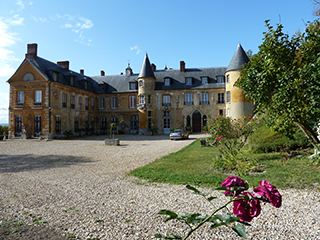Prochain point : lat="49.009933" lon="1.956584"

Château de Vaux
"And now the door opens wide to the arts" - Sully Prudhomme
From medieval fortress...
Its location overlooking the valley of the Seine made the Château de Vaux an important military vantage point in the Middle Ages. In the fifteenth century the stronghold was governed by the Lord of Meulan. It was at this time that Louis XI, King of France gave it to the famous Olivier le Daim, his barber and minister. The present château dates back to the fifteenth century, when it also had a drawbridge. It then underwent several alterations, particularly in the nineteenth century.
... to Castello Marochetti
The château was acquired in 1819 by a former member of the provisional government of Piedmont, Vincent Marochetti (1770-1822), lawyer at the Supreme Court and for the Council of State in Paris. He was commissioned by the Grand Duchess of Tuscany to purchase plaster in Vaux. He moved there and became mayor. At the beginning of the nineteenth century, the town hall was installed in a part of the château.
Carlo Marochetti (1805-1867), his son, was the official sculptor of Louis-Philippe and Queen Victoria. He sculpted the main altar of The Madeleine Church in Paris, one of the bas-reliefs of the Arc de Triomphe and the statue of Richard the Lion Heart in front of the Houses of Parliament in London. The château has hosted many European artistic and political figures such as Cavour, Rossini, Saint-Saëns and Sully Prudhomme. Like his father, Carlo Marochetti was Mayor of Vaux.
The château and park, which still belong to the same family, have been protected as historical monuments since 1996. The area covers 11 hectares encompassing many observation points, a vegetable garden, an orchard and a beautiful park. In 2011, an archaeological perimeter was established for further excavations. In 2012, the label "Maisons des Illustres " (houses of the illustrious) was awarded for the European standing of the artist.





